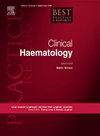我们如何干预以减轻AML移植后复发?减轻AML移植后复发的策略
IF 2.2
4区 医学
Q3 HEMATOLOGY
引用次数: 1
摘要
虽然同种异体造血干细胞移植是治疗急性髓系白血病(AML)的一种方法,但复发是常见的。目前正在开发几种策略,如调节方案的选择、供体淋巴细胞输注、药物制剂和细胞治疗方法,以改善移植结果。本文概述了降低AML移植后复发负担的一些重要干预措施和注意事项。本文章由计算机程序翻译,如有差异,请以英文原文为准。
How can we intervene to mitigate post-transplantation relapse in AML? Strategies to mitigate post-transplantation relapse in AML
Although allogeneic hematopoietic stem cell transplantation (allo-HSCT) is a curative approach for patients with acute myeloid leukemia (AML), relapse is a common occurrence. Several strategies, such as choice of conditioning regimen, donor lymphocyte infusions, pharmacologic agents, and cellular therapy approaches, are currently being developed to improve transplantation outcomes. This review outlines some important interventions and considerations to lower the burden of post-transplantation relapse in AML.
求助全文
通过发布文献求助,成功后即可免费获取论文全文。
去求助
来源期刊
CiteScore
4.20
自引率
0.00%
发文量
42
审稿时长
35 days
期刊介绍:
Best Practice & Research Clinical Haematology publishes review articles integrating the results from the latest original research articles into practical, evidence-based review articles. These articles seek to address the key clinical issues of diagnosis, treatment and patient management. Each issue follows a problem-orientated approach which focuses on the key questions to be addressed, clearly defining what is known and not known, covering the spectrum of clinical and laboratory haematological practice and research. Although most reviews are invited, the Editor welcomes suggestions from potential authors.

 求助内容:
求助内容: 应助结果提醒方式:
应助结果提醒方式:


